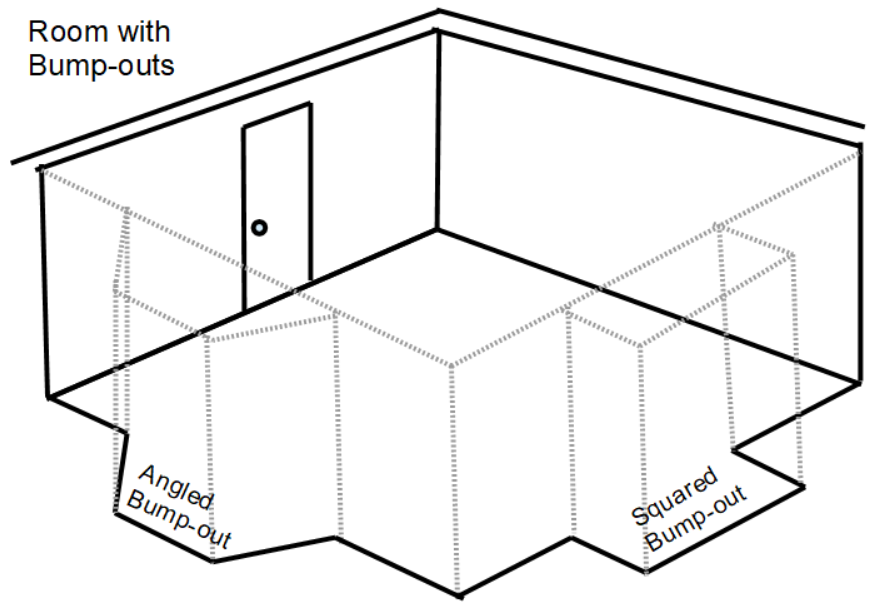The Rolls of Insulation for the Walls of a Room calculator computes the number of rolls or batts of insulation needed for the WALLS of a room based on the length and height of the four walls. The calculator assumes standard 16" spacing on the studs.
INSTRUCTIONS: Choose units and enter the following:
- (L) Length of Room
- (W) Width of Room
- (H) Height of Room
- (RL) Insulation Roll Length
- (RW) Insulation Roll Width (16" in diagram)
- (RP) Price per Unit (Roll or bag of Batts)
- (n) Number of Lengths per unit (1 for rolls, more for batts based on thickness)
Insulation Rolls for a Room (nR): The calculator returns number of rolls or batts of insulation (rounded up), the total linear feet of insulation and the approximate cost of insulation.
The Math/Science
Studs are usually spaced at 16" intervals. For this reason many rolls of insulation and batts are 15" wide. This accounts for the space taken up by the studs with the rolls or batt filling the space between the studs. Most rooms have eight foot (8') ceiling. That is why the default height is 8'. Feel free to enter a different value for the height. Note, many bags of bats are 7.75 feet long. These fit nicely between studs and fill the void in an 8' wall since 3" of length is reduced for the bottom and top plates.
The defaults for the Insulation Roll Length, Width and Price are for R-15 rolls from the price survey below. Again, feel free to enter your own values to match the product you're considering.
The Insulation Pricing Survey Data is maintained to assist in making rough price estimates for projects, vCalc performs periodic pricing surveys of nationally advertised commodities, in this case, insulation. The pricing came from the website of the Store at the Date specified. This is for rough calculating convenience and local pricing should ALWAYS be used.
The Insulation Pricing Survey Data information is as follows:
- Date: 12/6/23 at Store: Menards
- Insulation Pricing in U.S. dollars per unit:
- Blow-in Cellulose Insulation 25lb Bags: $16.98 per bag
- Blow-in Fiberglass Insulation 28.6lb Bags: $55.98 per bag
- Fiberglass Rolls: R value (Width x Length) $ per roll
- R-11 Roll (15" x 40') $16.98 per roll
- R-13 Roll (23" x 32') $35.98 per roll
- R-15 Roll (15" x 18') $24.18 per roll
- R-19 Roll (23" x 39'2") $58.89 per roll
- R-25 Roll (15" x 18') $19.99 per roll
- R-30 Roll (15" x 22') $31.48 per roll
- Fiberglass Batts: R value, (Width x Length x Batts per Bag), $per Bag
- R-13 (15" x 7.75' x 11) $67.96 per bag
- R-15 (15" x 7.75' x 7) $68.58 per bag
- R-19 (15" x 7.75' x 9) $67.48 per bag
- R-30 (24" x 4' x 11) $108.0 per bag
CAUTION: The pricing information provided is for calculating convenience with NO implied guarantees to the accuracy of the values listed. Authoritative sources should be sought to confirm any value before risking health or wealth on the veracity of the data. Furthermore, Calc gives no guarantee that you will be able to buy products at listed prices or even if they will be available. The data provided is purely a convenience for making estimates, so we strongly recommend that one ALWAYS use local pricing and authoritative specifications.
INSULATION (THERMAL) is a material used to inhibit heat transfer. More simply, insulation keeps-in heat when it's cold outside, or keeps-out heat when it's hot outside. It's used in buildings, vehicles and boats. It's used in roofs, walls, floors and around pipes to keep them from freezing or losing heat in hot water. Insulation is a value contributor with good return on investment by lowering heating and cooling costs. It is also an environmental plus by reducing the energy needed to maintain comfortable temperatures where humans and animals spend time.
Thermal insulation used in construction comes in several shapes and products. The most common form is rolls of fiberglass known as batting. These rolls are rolled out and placed between studs in exterior walls, between rafters and trusses in attics with no floor, or between joists in attics or on first floors where the underside is exposed to the outside (e.g., crawl spaces). Another common form of insulation is blow-in or sprayed-in material that conforms to the area applied. The common products include cellulose, which is treated paper, shredded polystyrene, loose fiberglass and denim. Styrofoam panels are another common insulating material.
Batts (batting sheets) are sections of insulation attached to paper or foil that allows them to be laid between joist or rafters in a way where the paper or foil is used to fix the batt to rafter. Rolls of insulation (e.g., fiberglass) also will be attached to liner medium (paper or foil) and can be cut into length (batts) by the installer.
Loose insulation is best applied with an insulation blower. Loose insulation, such as cellulose, is normally treated for flame resistance, while fiberglass is naturally flame resistant. Blown-in insulation typically comes compressed in bags. These require the material to be appropriately expanded for optimum benefit. For cellulose and fiberglass, this expansion is easily done using an insulation blower with a 100 foot hose. Because power is not always available and the use of a blower is not always convenient, raked insulation is also available.
The effectiveness of thermal insulation increases by the thickness of the layer of insulation. The following table shows the per inch increase in R Value of different materials. The R-value in insulation refers to the material's thermal resistance or its ability to resist the flow of heat. It measures how effectively an insulation material can prevent heat from passing through it. The higher the R-value, the greater the material's insulating effectiveness.
R-value is an essential metric used to assess and compare the thermal performance of different types of insulation. It helps determine the appropriate type and thickness of insulation needed in buildings to achieve desired energy efficiency and comfort levels.
Building codes and standards often specify minimum R-values for insulation in various parts of a structure, such as walls, roofs, floors, and ceilings. The recommended R-value depends on factors like climate, local regulations, and the desired level of energy efficiency.
Different insulation materials have varying R-values per inch of thickness. For instance, fiberglass, cellulose, foam board, spray foam, and other types of insulation materials have different R-values. Combining insulation materials or increasing the thickness of the insulation can improve the overall R-value of the building envelope, reducing heat transfer and improving energy efficiency.
It's important to note that while R-value is a critical factor in assessing insulation performance, other factors like installation quality, air sealing, moisture resistance, and building design also play significant roles in the overall energy efficiency and effectiveness of insulation in a structure.
Insulation Calculator Functions and Data:
- Insulation Rolls for Walls in a Room: Computes the number of rolls of insulation needed between the studs in a room based on the dimensions of the room and the rolls of insulation.
- Insulation Rolls between Joists, Trusses or Rafters: Computes the number of rolls of insulation needed to cover an attic area between and over joist, rafters and trusses based on the dimensions of the area and the length and width of the rolls of insulation.
- Cellulose Insulation by Area and Depth: Computes the number of 25lb bags of cellulose needed to insulate an area at a specified depth. It also computes the estimated R Value and estimated cost based on the price per bag of cellulose insulation.
- Cellulose Insulation by Area and R Value: Compute the Cellulose Insulation by Area and Depth calculator computes the number of 25 pound bags of cellulose insulation are needed to cover an area to achieve a specified R Value. It also provides the depth of insulation needed and estimated cost based on the price per bag of cellulose insulation.
- Loose Fiberglass Insulation by Area and Depth: Computes the number of bags (27lb to 29lb) of fiberglass needed for an area at a specified depth of insulation. It also estimates the R Value achieved and estimated cost based on the price per bag of cellulose insulation.
- Loose Fiberglass Insulation by Area and R Value: Computes the number of bags (27lb to 29lb) of fiberglass needed for an area based on desired R Value. It also computes the estimated depth of insulation needed to achieve R Value and estimated cost based on the price per bag of cellulose insulation.
- Shake and Rake Insulation Calculator: Computes the number of bags of loose (raked) insulation for an area at a specified depth. It also computes the estimated R Value.
Room Calculators
- Volume of a Room: Computes the cubic feet (volume) of a room based on its height, length and width.
- Areas of a Room: Computes the total square feet (area) of a room based on its height, length and width. This includes the total area of the ceiling and walls for things like paint. It also individually includes the area of the ceiling, walls and floor of a room.
- Room Paint Cost: Estimates the gallons of paint needed and associated cost to paint a room based on the room dimensions, number of coats and the unit cost of paint per gallon.
- Wallpaper for a Room: Computes the number of rolls of wallpaper needed to cover the walls of a room based on the dimensions of the room and the rolls of wallpaper.
- BTUs per Hour to Heat a Room: Computes the energy (heat) required to heat a space of a certain volume by a specified temperature variance.
- Insulation Rolls for Walls of a Room:
Computes the number of rolls or batts of insulation needed for the WALLS of a room based on the length and height of the four walls. The calculator assumes standard 16" spacing on the studs.
- Drywall Materials for a Room: Computes the number of drywall boards (4x8 or 4x12), number of drywall nails or screws and gallons of joint compound need for a room based on the room's dimensions.
- Ceiling Tiles for a Room: Computes the number of ceiling tiles needed to cover the ceiling of a room based on the dimensions of the room and the tiles.
- Cost of Flooring a Room: Computes the square feet of a room and then applies the price per square feet of different flooring products (e.g., hardwood, carpeting, tile)
- Room Framing Cost: Computes the number of studs and plate boards for a room and estimates the cost of framing based on the unit price of the lumber.
- Outlets and Wiring for Room: Computes the number of outlets (boxes) and length of wire to connect them in a room based on the room dimensions and the outlet spacing.
- Total Surface Area of a Room: Computes the surface area of the interior of a rectangular room including the walls, ceiling and floor based on the length, width and height of the room.
